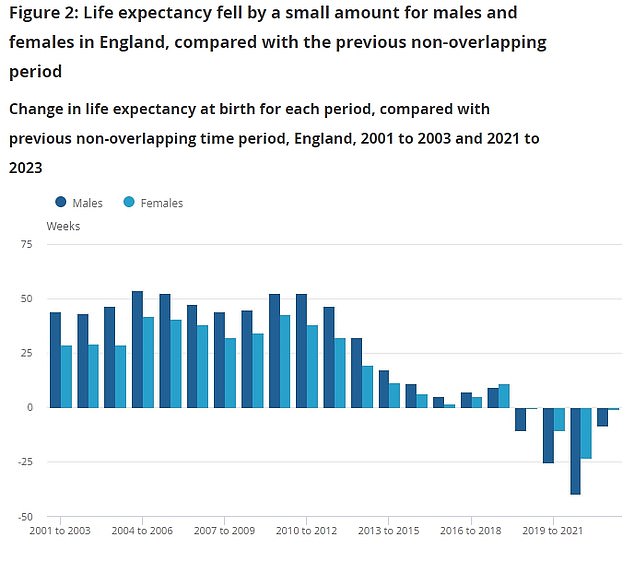Covid has cut life expectancy for British men by half a year – and by three months for women, new official data shows
Men’s life expectancy has fallen by six months since the Covid pandemic, while that of women has fallen by three months, new official figures show.
Children born in England and Wales are expected to live to 79 years, while women will live to an average of 83, the Office for National Statistics (ONS) revealed today.
That’s 26 weeks fewer for men and 13 weeks fewer for women than before the pandemic, according to the data.
Although life expectancy has increased over the past forty years due to advances in healthcare, living and working conditions, ssince 2011 it started to stagnate.
Although experts blame the recent decline mainly on Covid, they also point the finger at rising rates of heart disease. cancer And diabetes.
In England and Wales, life expectancy at birth between 2021 and 2023 was 79 years for men and 83 years for women, according to the Office for National Statistics (ONS).
More than two years ago, the Conservatives, who were in government at the time, promised to increase life expectancy in healthcare by five years by 2035.
However, the latest data suggests that England and Wales are still a long way from achieving this target.
There has been some recovery since the pandemic, with the latest figures representing an increase of thirteen weeks for men and an increase in life expectancy of eleven weeks for women.
But ONS data specialists suggested that an overall decline in quality of life could be another reason the figure is still low.
In recent years, Britain has faced a cost of living crisis, with experts warning that the risk of malnutrition was increasing due to high food and energy prices.
These ONS figures, the latest available, refer to average life expectancy, meaning some people will live less and others will live much longer.

Since 2011, life expectancy has begun to stagnate, with experts also blaming increased death rates on the Covid pandemic, as well as rising rates of heart disease, cancer and diabetes (Source: ONS)
Charities have previously warned that while life expectancy had recovered somewhat since the sharp fall in 2020, the recovery in the wake of the pandemic had not been as strong as expected.
They pointed to the prevalence of conditions, including heart disease and diabetes, that have helped stall further increases in life expectancy.
Referring to ONS figures released in January 2024, Veena Raleigh, senior fellow at The King’s Fund, said: ‘Although life expectancy has recovered somewhat since the sharp fall in 2020 when the pandemic struck, it has not had the recovery expected could have been. .
“It points to deeper problems with the nation’s health and the resilience of the health care system.
‘Much of the heavy burden of disease and death in Britain is caused by preventable conditions, such as heart disease, stroke, lung cancer and diabetes.’
How long you are expected to live also depends on where you live in Britain.
There is a difference of approximately one year in life expectancy between England and Wales, with data showing that life expectancy at birth in 2021 to 2023 is 79.1 years for men and 83 years for women in England and 78.1 years for men and 82 years for women in Wales.

In England and Wales, people aged 65 are estimated to live an additional 18.6 years for men and 21.1 years for women
Today, a boy born in Hart, Hampshire between 2020 and 2022 can expect to reach his 83rd birthday – the highest ever recorded.
Meanwhile, a boy born in Blackpool is likely to live to just 73, a gap of more than a decade.
The ONS estimates are based on a figure called period life expectancy.
This is a hypothetical measure that assumes that the death rates recorded in an area between 2020 and 2022 hold true throughout a person’s lifetime.
To arrive at this figure, use is made of the mortality registrations in the period 2020 to 2022 per age group, the chance of death and the number of survivors per group.
The life expectancy of the elderly has also decreased over the past ten years.
That is five weeks higher than in the period 2018 to 2020.
However, life expectancy at age 65 also remains below pre-pandemic levels of 18.8 years for men and 21.2 years for women in the period 2017-2019.
For 90-year-olds, life expectancy between 2021 and 2023 was 3.9 years for men and 4.6 years for women.
The improvement in life expectancy at the age of 90 has been low for several years.
But previous improvements in mortality over many decades and a historic peak in births, particularly around 1920 to 1921, have led to more people reaching prime age in recent years, ONS explains.
